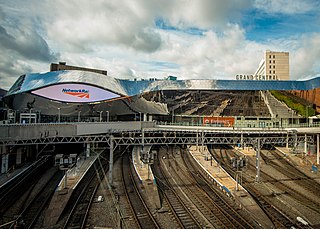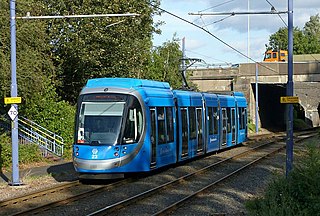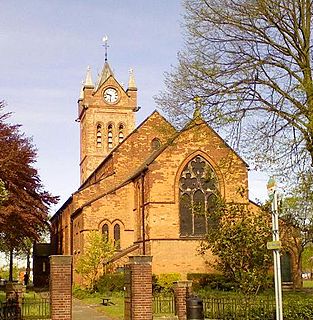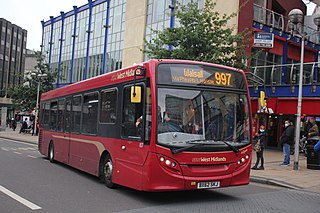
Birmingham New Street is the largest and busiest of the three main railway stations in Birmingham city centre, England, and a central hub of the British railway system. It is a major destination for Avanti West Coast services from London Euston, Glasgow Central and Edinburgh Waverley via the West Coast Main Line, the CrossCountry network, and for local and suburban services within the West Midlands; this includes those on the Cross-City Line between Lichfield Trent Valley, Redditch and Bromsgrove, and the Chase Line to Walsall and Rugeley Trent Valley. The three-letter station code is BHM.

The West Midlands Metro is a light-rail/tram system in the county of West Midlands, England. Opened on 30 May 1999, it currently consists of a single route, Line 1, which operates between the cities of Birmingham and Wolverhampton via the towns of Bilston, West Bromwich and Wednesbury, running on a mixture of reopened disused railway line and on-street running in urban areas. The line originally terminated at Birmingham Snow Hill station but, with extensions opened in 2015, 2019 and 2022, now runs via Birmingham city centre to terminate at Edgbaston. A further extension in Wolverhampton is scheduled to open in 2022.

Leeds railway station is the mainline railway station serving the city centre of Leeds in West Yorkshire, England. It is the fourth-busiest railway station in the UK outside London. It is located on New Station Street to the south of City Square, at the foot of Park Row, behind the landmark Queens Hotel. It is one of 20 stations managed by Network Rail.

Bloxwich is a market town in the Metropolitan Borough of Walsall, West Midlands, England, situated in the north of the borough and forming part of the Staffordshire/West Midlands border.

The MCW Metrobus is a two and three-axle double-decker bus manufactured by Metro Cammell Weymann (MCW) between 1977 and 1989, with over 4,000 built. The original MkI was superseded by the MkII which had a symmetrical windscreen with an arched top in 1981, although production of the original MkI continued for the Greater Manchester Passenger Transport Executive and London Regional Transport until 1983 and 1985 respectively. The Metrobus was conceived as an integral product manufactured completely by MCW, but Alexander and Northern Counties also bodied some examples.

Midland Red was a bus company that operated in The Midlands from 1905 until 1981. It was one of the largest English bus companies, operating over a large area between Gloucester in the south and Derbyshire in the north, and from Northampton to the Welsh border. The company also manufactured buses.

Bradford Interchange is a transport interchange in Bradford, West Yorkshire, England, which consists of a railway station and combined bus and coach station adjacent. The Interchange, which was designed in 1962, was hailed as a showpiece of European design and was opened on 14 January 1973. It is served by the majority of bus services in the city centre along with National Express Coaches, while the railway station, which is one of two in the city centre, is served by Northern and is also the terminus for Grand Central services from London King's Cross.

Scarborough railway station, formerly Scarborough Central, is a Grade II listed station serving the seaside town of Scarborough, North Yorkshire. It lies 42 miles (68 km) east of York and is one of the eastern termini on the North TransPennine route, operated by TransPennine Express. The station is also at the northern end of the Yorkshire Coast line and is reputed to have the longest station seat in the world at 456-foot (139 m) long.

Arriva Midlands is a bus operator providing services in the East Midlands and West Midlands areas of England. It is a subsidiary of Arriva UK Bus.

Arriva Yorkshire is a major bus operator providing services primarily within and across West Yorkshire, although it also provides service in some parts of South Yorkshire, East Riding of Yorkshire and southern areas of North Yorkshire. It is a subsidiary of Arriva UK Bus.

The Walsall–Wolverhampton line is a railway line in the West Midlands, England. It connects the town of Walsall to the city of Wolverhampton. The complete line does not currently have any regular scheduled passenger services: The line's local passenger service was withdrawn in 1965, it was restored in 1998, only to be withdrawn again in 2008. At present, the main use of the line is by freight trains, and it is also used as a diversionary route when engineering works are carried out on the West Coast Main Line.

Cheslyn Hay is a former mining village and civil parish which is contiguous with Great Wyrley and Landywood in Staffordshire, England. It is situated within the South Staffordshire district some 3 miles south of Cannock, 7 miles north of Walsall, 8.5 miles northeast of Wolverhampton and 12.5 miles south of the county town of Stafford. The West Midlands county border lies 2 miles to the south.

CrossCountry is a train operating company in the United Kingdom owned by Arriva UK Trains, operating the Cross Country franchise.

Diamond Bus Ltd., trading as Diamond West Midlands, is a bus operator in the West Midlands. It is a subsidiary of Rotala.

The Daimler Fleetline is a rear-engined double-decker bus chassis which was built between 1960 and 1983.
The Passenger Transport Executive (PTE) bus operations were the bus operating divisions of the passenger transport executives in the United Kingdom. In 1986 they underwent a process of deregulation and privatisation, forming some of the largest private bus companies in the UK outside London, with all being sold to their employees or management. Despite their relative size and lucrative operating areas, none of the companies survived beyond the late 1990s, with all falling into the hands of the major bus groups, who had their origins in privatised regional subsidiaries of the former National Bus Company and the Scottish Bus Group.

National Express West Midlands (NXWM) is a bus operator in the West Midlands that operates services in Birmingham, Dudley, Sandwell, Walsall, Wolverhampton, and Solihull, as well as limited routes outside of the general area of Birmingham, such as the X1 to Coventry, or the 144A to Worcester. NXWM a subsidiary of National Express.
Midland, previously known as Choice Travel, was a bus company operating mostly in the Wolverhampton and Walsall areas of the West Midlands. Some services also operated in the Staffordshire and Shropshire area.

Halesowen bus station is a bus station in the town of Halesowen in the West Midlands conurbation in England. It is owned and managed by Transport for West Midlands.

The West Midlands Passenger Transport Executive (WMPTE) was the public body responsible for public transport in the West Midlands metropolitan county in the United Kingdom from 1969 until 2016. The organisation operated under the name Centro from 1990, and was publicly branded as Network West Midlands from 2005.




















